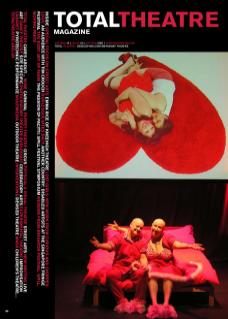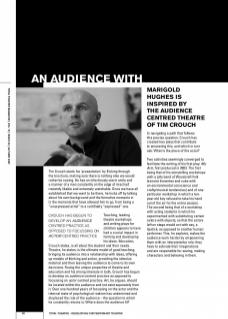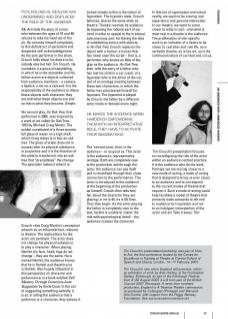Tim Crouch starts his ‘presentation’ by flicking through the brochure, making sure there is nothing else we would rather be seeing. He has an infectiously warm smile and a manner of a man constantly on the edge of mischief: instantly likeable and extremely watchable. Once we have all established that we want to be there, he kicks off by talking about his own background and the formative moments in it: the moments that have allowed him to go, from being a “unexpressed artist” to a certifiably “expressed” one.
Teaching, leading theatre workshops and writing plays for children appears to have had a crucial impact in forming and developing his ideas. Education, Crouch states, is all about the student and their needs. Theatre, he states, is the ultimate model of good teaching; bringing its audience into a relationship with ideas, offering up models of thinking and action, providing the stimulus material and then leaving the audience to come to its own decisions. Fusing the unique properties of theatre and education and his strong interests in both, Crouch has begun to develop an audience centred practice as opposed to focussing on actor centred practice. Art, he argues, should be located within the audience and not exist separately from it. Over one hundred years of focussing on the actor and the internal state of psychological realism has undermined and displaced the role of the audience – the question to which he constantly returns is: Where does the audience fit? In navigating a path that follows this precise question, Crouch has created two plays that contribute to answering this, and which in turn ask: What is the place of the actor?
Two activities seemingly converged to facilitate the writing of his first play: My Arm, first produced in 2003. The first being that of his storytelling workshops with a jolly band of Woodcraft Folk (secular brownies and cubs with an environmental conscience and crafty/musical tendencies) and of one particular workshop in which a ten year-old boy refused to take his hand out of the air for the entire session. The second being that of a workshop with acting students in which he experimented with substituting certain actors with objects, so that the actors left on stage would act with say, a lipstick, as opposed to another human performer. This, he explains, makes the audience work harder by empowering them with an interpretative role: they have to activate their imaginations and are responsible for seeing, making characters and believing in them.
My Arm tells the story of a man who between the ages of 10 and 40 refuses to take his hand out of the air. He commits himself completely to this defiant act of persistent and desperate self-acknowledgement. As the sole performer in the show, Crouch talks about his desire to be nobody else but him: Tim Crouch. He considers it a piece of storytelling, in which he is the storyteller and his fellow actors are objects collected from audience members – a camera, a lipstick, a mirror, a railcard. It is the responsibility of the audience to imbue these objects with character: they are told what these objects are and so that is what they become. Simple.
His second play, An Oak Tree, first performed in 2005, was inspired by a work of art called An Oak Tree, 1973 by Michael Craig Martin. The exhibit constituted of a three-quarter full glass of water on a high shelf, which Craig states is in fact an oak tree. The glass of water does not in anyway alter its physical substance or properties and it is the intention of the artist to transform it into an oak tree that “precipitates” the change. The spectator makes it what it is.
Crouch cites Craig Martin’s conceptual artwork as an influential text, relevant to theatre. The implications for the actor are pertinent. The actor does not change his physical substance to play a character. When playing Hamlet, his face, head, legs do not change – they are the same. He is named Hamlet, the audience knows that he is Hamlet and therefore he is Hamlet. Also hugely influential in this perspective on character and performance, is a book entitled Self Mastery Through Conscious Auto Suggestion by Emile Coué. In the act of suggesting something verbally, it is so: in telling the audience that a performer is a character, they believe it.
Linked closely to this is the notion of hypnotism. The hypnotic state, Crouch believes, shares the same state as theatre. Theatre reaches its audience by bypassing the rational part of our mind in order to appeal to the irrational, subconscious part. Furthering the idea of substituting actors with objects, in An Oak Tree, Crouch replaces the object with a human: a human that has never seen the script – that is, a performer who knows as little of the play as the audience. An Oak Tree, then, tells the story of a father who has lost his child in a car crash, of a hypnotist who is the driver of the car, and of an onstage meeting between these two characters, in which the father has volunteered himself for hypnosis. The hypnotist is played by Crouch, the father by a different actor (male or female) every night.
The ‘second actor, then, is the audience – or as good as. This actor is the audience’s representative onstage. Both are completely new to the production and through the actor, the audience can see itself and is revitalised through their close connection to the performance. This actor is introduced to the audience at the beginning of the production as himself. Crouch then tells him/ her about the character they are playing i.e. he is 45, he is 5ft 9 etc. They then begin. As the actor playing the father is completely new to the text, he/she is unable to clutter the role with psychological detail – the audience creates the character.
In this era of cyperspace and virtual reality, we seem to be craving real experience and genuine interaction. In our theatre, we want to come closer to what is real – and what is most real in a theatre is the audience. The proliferation of site-specific work is an indicator of a desire to be closer to real sites and real life, as is verbatim theatre, as is live art, as is the communal nature of carnival and circus.
Tim Crouch’s presentation focuses on reconfiguring the role of the actor within an audience centred practice. It is the audience who do the work. Perhaps we are moving closer to a new mode of acting, a mode of acting that is designed to bring us ever closer to an audience and to correspond to the current modes of theatre that require it. Such a mode of acting could help facilitate a model of theatre that primarily looks outwards to life and to audience for inspiration and not to an indulgent introspection of the actor and art. Take it away, Tim!
Tim Crouch’s presentation/workshop was part of How to Act, the first conference hosted by the Centre for Excellence in Training at Theatre at Central School of Speech and Drama, London, 14–17 February 2007.
Tim Crouch’s new show England will premiere, within an exhibition of work by Alex Hartley, at the Fruitmarket Gallery, Edinburgh, as part of the Edinburgh Festival, from 3–26 August 2007. It will form part of the British Council 2007 Showcase. A news from nowhere production, England is A Traverse Theatre commission, co-produced by Culturgest (Portugal) and Warwick Arts Centre, with support from the Peggy Ramsay Foundation. See www.newsfromnowhere.net


